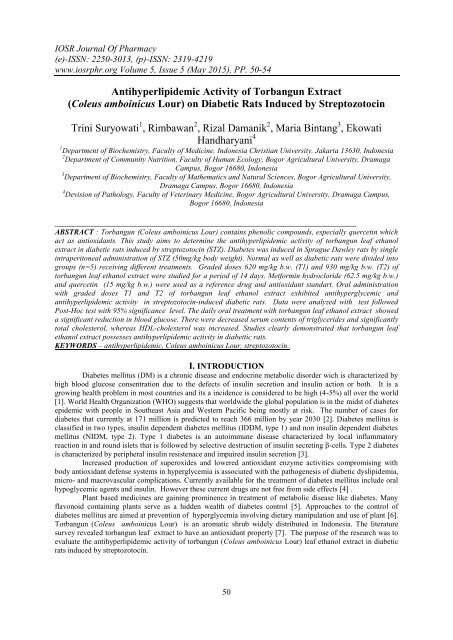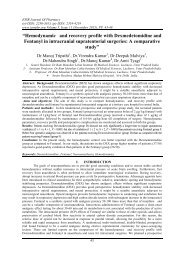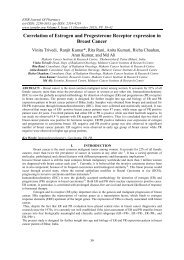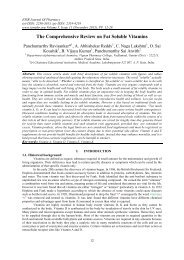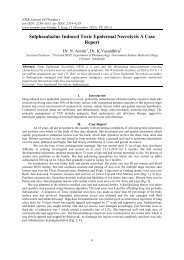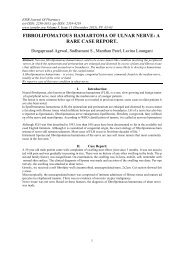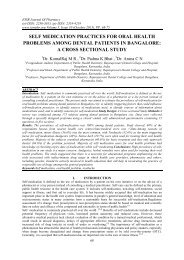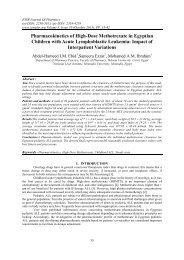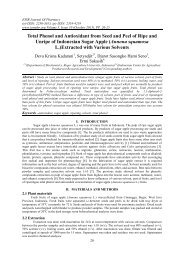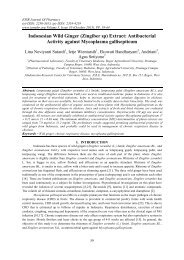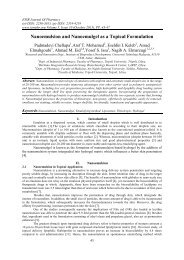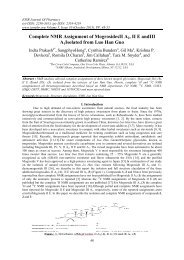Antihyperlipidemic Activity of Torbangun Extract (Coleus amboinicus Lour) on Diabetic Rats Induced by Streptozotocin
You also want an ePaper? Increase the reach of your titles
YUMPU automatically turns print PDFs into web optimized ePapers that Google loves.
IOSR Journal Of Pharmacy<br />
(e)-ISSN: 2250-3013, (p)-ISSN: 2319-4219<br />
www.iosrphr.org Volume 5, Issue 5 (May 2015), PP. 50-54<br />
<str<strong>on</strong>g>Antihyperlipidemic</str<strong>on</strong>g> <str<strong>on</strong>g>Activity</str<strong>on</strong>g> <str<strong>on</strong>g>of</str<strong>on</strong>g> <str<strong>on</strong>g>Torbangun</str<strong>on</strong>g> <str<strong>on</strong>g>Extract</str<strong>on</strong>g><br />
(<str<strong>on</strong>g>Coleus</str<strong>on</strong>g> <str<strong>on</strong>g>amboinicus</str<strong>on</strong>g> <str<strong>on</strong>g>Lour</str<strong>on</strong>g>) <strong>on</strong> <strong>Diabetic</strong> <strong>Rats</strong> <strong>Induced</strong> <strong>by</strong> <strong>Streptozotocin</strong><br />
Trini Suryowati 1 , Rimbawan 2 , Rizal Damanik 2 , Maria Bintang 3 , Ekowati<br />
Handharyani 4<br />
1 Department <str<strong>on</strong>g>of</str<strong>on</strong>g> Biochemistry, Faculty <str<strong>on</strong>g>of</str<strong>on</strong>g> Medicine, Ind<strong>on</strong>esia Christian University, Jakarta 13630, Ind<strong>on</strong>esia<br />
2 Department <str<strong>on</strong>g>of</str<strong>on</strong>g> Community Nutriti<strong>on</strong>, Faculty <str<strong>on</strong>g>of</str<strong>on</strong>g> Human Ecology, Bogor Agricultural University, Dramaga<br />
Campus, Bogor 16680, Ind<strong>on</strong>esia<br />
3 Department <str<strong>on</strong>g>of</str<strong>on</strong>g> Biochemistry, Faculty <str<strong>on</strong>g>of</str<strong>on</strong>g> Mathematics and Natural Sciences, Bogor Agricultural University,<br />
Dramaga Campus, Bogor 16680, Ind<strong>on</strong>esia<br />
4 Devisi<strong>on</strong> <str<strong>on</strong>g>of</str<strong>on</strong>g> Pathology, Faculty <str<strong>on</strong>g>of</str<strong>on</strong>g> Veterinary Medicine, Bogor Agricultural University, Dramaga Campus,<br />
Bogor 16680, Ind<strong>on</strong>esia<br />
__________________________________________________________________<br />
ABSTRACT : <str<strong>on</strong>g>Torbangun</str<strong>on</strong>g> (<str<strong>on</strong>g>Coleus</str<strong>on</strong>g> <str<strong>on</strong>g>amboinicus</str<strong>on</strong>g> <str<strong>on</strong>g>Lour</str<strong>on</strong>g>) c<strong>on</strong>tains phenolic compounds, especially quercetin which<br />
act as antioxidants. This study aims to determine the antihyperlipidemic activity <str<strong>on</strong>g>of</str<strong>on</strong>g> torbangun leaf ethanol<br />
extract in diabetic rats induced <strong>by</strong> streptozotocin (STZ). Diabetes was induced in Sprague Dawley rats <strong>by</strong> single<br />
intraperit<strong>on</strong>eal administrati<strong>on</strong> <str<strong>on</strong>g>of</str<strong>on</strong>g> STZ (50mg/kg body weight). Normal as well as diabetic rats were divided into<br />
groups (n=5) receiving different treatments. Graded doses 620 mg/kg b.w. (T1) and 930 mg/kg b.w. (T2) <str<strong>on</strong>g>of</str<strong>on</strong>g><br />
torbangun leaf ethanol extract were studied for a period <str<strong>on</strong>g>of</str<strong>on</strong>g> 14 days. Metformin hydrocloride (62.5 mg/kg b.w.)<br />
and quercetin (15 mg/kg b.w.) were used as a reference drug and antioxidant standart. Oral administrati<strong>on</strong><br />
with graded doses T1 and T2 <str<strong>on</strong>g>of</str<strong>on</strong>g> torbangun leaf ethanol extract exhibited antihyperglycemic and<br />
antihyperlipidemic activity in streptozotocin-induced diabetic rats. Data were analyzed with test followed<br />
Post-Hoc test with 95% significance level. The daily oral treatment with torbangun leaf ethanol extract showed<br />
a significant reducti<strong>on</strong> in blood glucose. There were decreased serum c<strong>on</strong>tents <str<strong>on</strong>g>of</str<strong>on</strong>g> triglycerides and significantly<br />
total cholesterol, whereas HDL-cholesterol was increased. Studies clearly dem<strong>on</strong>strated that torbangun leaf<br />
ethanol extract possesses antihyperlipidemic activity in diabettic rats.<br />
KEYWORDS – antihyperlipidemic, <str<strong>on</strong>g>Coleus</str<strong>on</strong>g> <str<strong>on</strong>g>amboinicus</str<strong>on</strong>g> <str<strong>on</strong>g>Lour</str<strong>on</strong>g>, streptozotocin.<br />
I. INTRODUCTION<br />
Diabetes mellitus (DM) is a chr<strong>on</strong>ic disease and endocrine metabolic disorder wich is characterized <strong>by</strong><br />
high blood glucose c<strong>on</strong>sentrati<strong>on</strong> due to the defects <str<strong>on</strong>g>of</str<strong>on</strong>g> insulin secreti<strong>on</strong> and insulin acti<strong>on</strong> or both. It is a<br />
growing health problem in most countries and its a incidence is c<strong>on</strong>sidered to be high (4-5%) all over the world<br />
[1]. World Health Organizati<strong>on</strong> (WHO) suggests that worldwide the global populati<strong>on</strong> is in the midst <str<strong>on</strong>g>of</str<strong>on</strong>g> diabetes<br />
epidemic with people in Southeast Asia and Western Pacific being mostly at risk. The number <str<strong>on</strong>g>of</str<strong>on</strong>g> cases for<br />
diabetes that currently at 171 milli<strong>on</strong> is predicted to reach 366 milli<strong>on</strong> <strong>by</strong> year 2030 [2]. Diabetes mellitus is<br />
classified in two types, insulin dependent diabetes mellitus (IDDM, type 1) and n<strong>on</strong> insulin dependent diabetes<br />
mellitus (NIDM, type 2). Type 1 diabetes is an autoimmune disease characterized <strong>by</strong> local inflammatory<br />
reacti<strong>on</strong> in and round islets that is followed <strong>by</strong> selective destructi<strong>on</strong> <str<strong>on</strong>g>of</str<strong>on</strong>g> insulin secreting β-cells. Type 2 diabetes<br />
is characterized <strong>by</strong> peripheral insulin resistenace and impaired insulin secreti<strong>on</strong> [3].<br />
Increased producti<strong>on</strong> <str<strong>on</strong>g>of</str<strong>on</strong>g> superoxides and lowered antioxidant enzyme activities compromising with<br />
body antioxidant defense systems in hyperglycemia is associated with the pathogenesis <str<strong>on</strong>g>of</str<strong>on</strong>g> diabetic dyslipidemia,<br />
micro- and macrovascular complicati<strong>on</strong>s. Currently available for the treatment <str<strong>on</strong>g>of</str<strong>on</strong>g> diabetes mellitus include oral<br />
hypoglycemic agents and insulin. However these current drugs are not free from side effects [4] .<br />
Plant based medicines are gaining prominence in treatment <str<strong>on</strong>g>of</str<strong>on</strong>g> metabolic disease like diabetes. Many<br />
flav<strong>on</strong>oid c<strong>on</strong>taining plants serve as a hidden wealth <str<strong>on</strong>g>of</str<strong>on</strong>g> diabetes c<strong>on</strong>trol [5]. Approaches to the c<strong>on</strong>trol <str<strong>on</strong>g>of</str<strong>on</strong>g><br />
diabetes mellitus are aimed at preventi<strong>on</strong> <str<strong>on</strong>g>of</str<strong>on</strong>g> hyperglycemia involving dietary manipulati<strong>on</strong> and use <str<strong>on</strong>g>of</str<strong>on</strong>g> plant [6].<br />
<str<strong>on</strong>g>Torbangun</str<strong>on</strong>g> (<str<strong>on</strong>g>Coleus</str<strong>on</strong>g> <str<strong>on</strong>g>amboinicus</str<strong>on</strong>g> <str<strong>on</strong>g>Lour</str<strong>on</strong>g>) is an aromatic shrub widely distributed in Ind<strong>on</strong>esia. The literature<br />
survey revealed torbangun leaf extract to have an antioxidant property [7]. The purpose <str<strong>on</strong>g>of</str<strong>on</strong>g> the research was to<br />
evaluate the antihyperlipidemic activity <str<strong>on</strong>g>of</str<strong>on</strong>g> torbangun (<str<strong>on</strong>g>Coleus</str<strong>on</strong>g> <str<strong>on</strong>g>amboinicus</str<strong>on</strong>g> <str<strong>on</strong>g>Lour</str<strong>on</strong>g>) leaf ethanol extract in diabetic<br />
rats induced <strong>by</strong> streptozotocin.<br />
50
51<br />
<str<strong>on</strong>g>Antihyperlipidemic</str<strong>on</strong>g> <str<strong>on</strong>g>Activity</str<strong>on</strong>g> <str<strong>on</strong>g>of</str<strong>on</strong>g> <str<strong>on</strong>g>Torbangun</str<strong>on</strong>g>…<br />
II. MATERIALS AND METHODS<br />
2.1.Plant materials.<br />
Leaves <str<strong>on</strong>g>of</str<strong>on</strong>g> torbangun (<str<strong>on</strong>g>Coleus</str<strong>on</strong>g> <str<strong>on</strong>g>amboinicus</str<strong>on</strong>g> <str<strong>on</strong>g>Lour</str<strong>on</strong>g>) were collected from a herbal garden in Cibeureum<br />
Bogor, West Java, Ind<strong>on</strong>esia in the m<strong>on</strong>ths <str<strong>on</strong>g>of</str<strong>on</strong>g> January to March 2014. The leaves separated, cleaned, air-dried,<br />
coarsely powdered, and subjected for Soxhlet-extracti<strong>on</strong> <strong>by</strong> using ethanol. Powder weighing 70 g was extracted<br />
with 600 ml <str<strong>on</strong>g>of</str<strong>on</strong>g> 96% ethyl alcohol for 72 h for each batch. The solvent was recovered using rotovapour (Buchi,<br />
Switzerland). The semisolid mass obtained was c<strong>on</strong>centrated under reduced pressure and stored in an air tight<br />
c<strong>on</strong>tainer [8].<br />
2.2. Chemistry :<br />
<strong>Streptozotocin</strong> (STZ) purchased from Sigma-Aldrich Chemie (Germany). Quercetin: extraced from<br />
Sophora Jap<strong>on</strong>ica L, was optained from Shanghai Seni Pharma-Tech Co, Ltd (Chika). Metformin<br />
Hydrochlorida, purchased from Sigma-Aldrich Chemie (Germany).<br />
2.3. Animal<br />
Healthy male Sprague-Dawley rats (180-200 gr) breed in BPOM Jakarta-Ind<strong>on</strong>esia. Animals were kept<br />
at room temperature (26 ± 2 o C) with 12 h light/dark cycle for 1 week to acclimatize to laboratory c<strong>on</strong>diti<strong>on</strong>s<br />
before starting the experiment. They were given free access to food with standart diet and water ad libitum.<br />
2.4. Inducti<strong>on</strong> <str<strong>on</strong>g>of</str<strong>on</strong>g> diabetes in experimental animals.<br />
The animals were fasted overnight and diabetes was induced <strong>by</strong> a single intra perit<strong>on</strong>eal (ip) injecti<strong>on</strong><br />
<str<strong>on</strong>g>of</str<strong>on</strong>g> a freshly preparat soluti<strong>on</strong> <str<strong>on</strong>g>of</str<strong>on</strong>g> <strong>Streptozotocin</strong> (STZ) 50 mg/kg b.w. in 0.1 M sitrat buffer (pH 4.5). To avoid an<br />
early fatal hypoglycemic state, a 5% glucose soluti<strong>on</strong> was fed for 1 day to all the animals. Blood glucose <str<strong>on</strong>g>of</str<strong>on</strong>g> all<br />
rats was estimated after 48 hours. <strong>Rats</strong> with fasting blood glucose level <str<strong>on</strong>g>of</str<strong>on</strong>g> 220-415 mg/dl were c<strong>on</strong>sidered as<br />
diabetic and selected for further study[9].<br />
2.5. Experimental design<br />
A total <str<strong>on</strong>g>of</str<strong>on</strong>g> 30 rats were divided into six groups <str<strong>on</strong>g>of</str<strong>on</strong>g> five animals each. The daily oral treatments using<br />
suspensi<strong>on</strong> <str<strong>on</strong>g>of</str<strong>on</strong>g> each extract were c<strong>on</strong>tinued for 14 days, with destilled water serving as the vehicle. Suspensi<strong>on</strong>s<br />
were prepared using 0.3% w/v sodium carboxy methylcellulose in destillat water and used for the experimental<br />
purpose. The volume <str<strong>on</strong>g>of</str<strong>on</strong>g> the suspensi<strong>on</strong> or vehicle was 5 ml/kg. All the groups received daily treatment orally<br />
between 08.00 and 09.00 h : (i) Group 1, animal c<strong>on</strong>trol (vehicle treated with 5 ml/kg b.w. <str<strong>on</strong>g>of</str<strong>on</strong>g> destillat water);<br />
(ii) Group 2, diabetic c<strong>on</strong>trol (vehicle treated with 5 ml/kg b.w. <str<strong>on</strong>g>of</str<strong>on</strong>g> destillat water); (iii) Group 3, diabetic rats<br />
treated with torbangun leaf ethanol extract dose 620 mg/kg b.w. (T1); (iv) Group 4, diabetic rats treated with<br />
torbangun leaf ethanol extract dose 930 mg/kg b.w. (T2); (v) Group 5, diabetic rats treated with Metformin<br />
hydrocloride dose 62.5 mg/kg b.w. [10] ; (vi) group 6, diabetic rats treated with Quercetin dose 15 mg/kg<br />
b.w.[11]. At the end <str<strong>on</strong>g>of</str<strong>on</strong>g> the experimental period, the animals were deprived <str<strong>on</strong>g>of</str<strong>on</strong>g> food over night anesthesia, blood<br />
was collected immediately for biochemical analyses.<br />
2.6. Sample collecti<strong>on</strong><br />
Blood samples were collected from tip <str<strong>on</strong>g>of</str<strong>on</strong>g> rat tail and blood glucose levels estimated using Gluco-check<br />
electr<strong>on</strong>ic glucometer (Gluco-check, Delhi) and body weight measured during treatment <strong>on</strong> weekly basis (i.e. 0,<br />
1, 4, 7, 10 and 14 days). Blood was collected <strong>by</strong> cardiac puncture and immediately transferred into tubes<br />
c<strong>on</strong>taining EDTA. Blood was then centrifuged at 6.000 g for 8 min recover serum for the estimati<strong>on</strong> c<strong>on</strong>tents <str<strong>on</strong>g>of</str<strong>on</strong>g><br />
total cholesterol (TC), triglycerides (TGs) and HDL-cholesterol level were estimated using commercial<br />
diagnostic kits (Rajawali-Nusindo). All estimati<strong>on</strong>s were performed according to the kit manufacturer’s<br />
instructi<strong>on</strong> [12].<br />
2.7. Statistical analysis:<br />
The results were expressed as the mean±SEM. The results obtained from the present study were<br />
analyzed using One-way ANOVA followed <strong>by</strong> Dunnett’s multiple comparis<strong>on</strong> tests. Data was computed for<br />
statistical analysis using Graph Pad Prism S<str<strong>on</strong>g>of</str<strong>on</strong>g>tware. Differences between the data were c<strong>on</strong>sidered significant at<br />
P
<str<strong>on</strong>g>Antihyperlipidemic</str<strong>on</strong>g> <str<strong>on</strong>g>Activity</str<strong>on</strong>g> <str<strong>on</strong>g>of</str<strong>on</strong>g> <str<strong>on</strong>g>Torbangun</str<strong>on</strong>g>…<br />
body weight in dose T2 diabetic c<strong>on</strong>trol animals compared to test drug treated animals. Reduced body weight<br />
indicates the inducti<strong>on</strong> <str<strong>on</strong>g>of</str<strong>on</strong>g> diabetes. Oral administrati<strong>on</strong> <str<strong>on</strong>g>of</str<strong>on</strong>g> torbangun (<str<strong>on</strong>g>Coleus</str<strong>on</strong>g> <str<strong>on</strong>g>amboinicus</str<strong>on</strong>g> <str<strong>on</strong>g>Lour</str<strong>on</strong>g>) leaf ethanol<br />
extract dose T1: 620 mg/kg b.w. to diabetic rats improved body weight significantly (P
<str<strong>on</strong>g>Antihyperlipidemic</str<strong>on</strong>g> <str<strong>on</strong>g>Activity</str<strong>on</strong>g> <str<strong>on</strong>g>of</str<strong>on</strong>g> <str<strong>on</strong>g>Torbangun</str<strong>on</strong>g>…<br />
Table 3 showed oral treatment with doses T1 showed reducti<strong>on</strong> in serum c<strong>on</strong>tents <str<strong>on</strong>g>of</str<strong>on</strong>g> total cholesterol,<br />
triglycerides and simultaneously increased the HDL-cholesterol levels as compared to the diabetic c<strong>on</strong>trol<br />
group. Administrati<strong>on</strong> <str<strong>on</strong>g>of</str<strong>on</strong>g> torbangun (<str<strong>on</strong>g>Coleus</str<strong>on</strong>g> <str<strong>on</strong>g>amboinicus</str<strong>on</strong>g> <str<strong>on</strong>g>Lour</str<strong>on</strong>g>) leaf ethanol extract at dose T1 620 mg/kg b.w.;<br />
dose T2 930 mg/kg b.w. and standard drug metformin hydrochloride, quercetin resulted fall <str<strong>on</strong>g>of</str<strong>on</strong>g> these serum<br />
lipoproteins when compared to diabetic rats. After 14 days treated <str<strong>on</strong>g>of</str<strong>on</strong>g> the extract, metformin hydrochloride and<br />
quercetin, there was a elevati<strong>on</strong> in HDL level in serum and the results were found to be comparable to that <str<strong>on</strong>g>of</str<strong>on</strong>g><br />
c<strong>on</strong>trol rats.<br />
Table 3. Effect <str<strong>on</strong>g>of</str<strong>on</strong>g> torbangun (<str<strong>on</strong>g>Coleus</str<strong>on</strong>g> <str<strong>on</strong>g>amboinicus</str<strong>on</strong>g> <str<strong>on</strong>g>Lour</str<strong>on</strong>g>) leaf ethanol extract <strong>on</strong> lipids level in diabetic<br />
rats<br />
Group Cholesterol<br />
(mg/dL)<br />
Triglycerides<br />
(mg/dL)<br />
HDL<br />
(mg/dL)<br />
N 51.2 ± 16.485 b 84.4 ± 8.849 a 50.4 ± 7.392 a<br />
D 98.4 ± 22.966 a 115.2 ± 59.439 a 22.2 ± 13.014 b<br />
D-T1 66.4 ± 17.534 b 78 ± 16.309 a 38.2 ± 12.812 ab<br />
D-T2 77.4 ± 8.163 ab 99.4 ± 24.532 a 41.4 ± 13.276 ab<br />
D-Mt 76.4 ± 19.085 ab 93.6 ± 19.926 a 40.4 ± 11.128 ab<br />
D-Q 74.6 ± 17.828 ab 81.8 ± 21.738 a 43.6 ± 14.277 a<br />
P-value 0,0275* 0,5231 0,0696<br />
Data are expressed as mean ± S.E.M; n=5 animals in each group. Values are statistically significant at *P
<str<strong>on</strong>g>Antihyperlipidemic</str<strong>on</strong>g> <str<strong>on</strong>g>Activity</str<strong>on</strong>g> <str<strong>on</strong>g>of</str<strong>on</strong>g> <str<strong>on</strong>g>Torbangun</str<strong>on</strong>g>…<br />
V. CONCLUSION<br />
In c<strong>on</strong>clusi<strong>on</strong>, the present study indicates treatment <str<strong>on</strong>g>of</str<strong>on</strong>g> STZ-treated rats with torbangun (<str<strong>on</strong>g>Coleus</str<strong>on</strong>g><br />
<str<strong>on</strong>g>amboinicus</str<strong>on</strong>g> <str<strong>on</strong>g>Lour</str<strong>on</strong>g>) for two c<strong>on</strong>secutive weeks could restore the biotransformati<strong>on</strong> <strong>by</strong> shifting the balance <str<strong>on</strong>g>of</str<strong>on</strong>g> lipid<br />
and carbohydrate metabolism. The extract showed significant antihyperglicemic with very crucial effects <strong>on</strong><br />
lipids levels as antihyperlipidemic.<br />
VI. ACKNOWLEDGEMENT<br />
This research was funded <strong>by</strong> Ind<strong>on</strong>esia Christian University, Jakarta 13630 Ind<strong>on</strong>esia. We thank to<br />
Mr Taka Jacobs <str<strong>on</strong>g>of</str<strong>on</strong>g> torbangun (<str<strong>on</strong>g>Coleus</str<strong>on</strong>g> <str<strong>on</strong>g>amboinicus</str<strong>on</strong>g> <str<strong>on</strong>g>Lour</str<strong>on</strong>g>) garden.<br />
REFERENCES<br />
[1] Farsaei SH, Sabzghabaee AM, Zargarzadeh AH, Amini M., Effect <str<strong>on</strong>g>of</str<strong>on</strong>g> pharmacist-led patient educati<strong>on</strong> <strong>on</strong> glycemic c<strong>on</strong>trol <str<strong>on</strong>g>of</str<strong>on</strong>g><br />
type 2 diabetics: a randomized c<strong>on</strong>trolled trial, Journal <str<strong>on</strong>g>of</str<strong>on</strong>g> Research in Medical Sciences, 16(1), 2011<br />
[2] Global Diabetes Plant at a Glance IDF – Global Diabetes Plant 2011-2021.<br />
[3] Srinivasan K, Viswanad B, Lydia A, Kaul CL, Ramarao P∗., Combinati<strong>on</strong> <str<strong>on</strong>g>of</str<strong>on</strong>g> high-fat diet-fed and low-dose streptozotocintreated<br />
rat: A model for type 2 diabetes and pharmacological screening, Pharmacological Research, 52, 2005, 313–320<br />
[4] Atef EAE. Quercetin protective acti<strong>on</strong> <strong>on</strong> oxidative stress,sorbitol, insulin resistance and β - cells functi<strong>on</strong> in experimental<br />
diabetic rats. Internati<strong>on</strong>al Journal <str<strong>on</strong>g>of</str<strong>on</strong>g> Pharmaceutical Studies and Research, EISSN, 2011, 2229- 4619.<br />
[5] Cazarolli LH, Zanatta L, Albert<strong>on</strong> EH, Res BF, Maria S, Folaor P, Damazio RG, Pizzolat MG, Mena: Flav<strong>on</strong>oids, Cellular and<br />
molecular mechanism <str<strong>on</strong>g>of</str<strong>on</strong>g> acrti<strong>on</strong> in glucose homeostasis. Mini Review in Medicinal Chemistry.Bentham Science Publishers,<br />
18(10), 2008, 1032-1038<br />
[6] Pallab Das Gupta and Amartya, Diabetes Mellitus and its Herbal Treatment, Internati<strong>on</strong>al Journal <str<strong>on</strong>g>of</str<strong>on</strong>g> Research in ISSN,3(2),<br />
2012, 2229-3701.<br />
[7] Kumar GS, Nayaka H, Dharmesh SM and Salimath PV. Free and bound phenolic antioxidants in amla (Emblica <str<strong>on</strong>g>of</str<strong>on</strong>g>ficinalis) and<br />
turmeric (Curcuma l<strong>on</strong>ga). Journal <str<strong>on</strong>g>of</str<strong>on</strong>g> Food Compositi<strong>on</strong>, 19, 2006, 446-452.<br />
[8] Shanbhag T, Shenoy S, Rao MC, Woundhealin pr<str<strong>on</strong>g>of</str<strong>on</strong>g>ile<str<strong>on</strong>g>of</str<strong>on</strong>g>Tinospora cordifolia, Indian drugs, 42, 2005, 217-222<br />
[9] Prem Kn, Annamalai A and Thakur RS, Quercetin Attenuates Altered Col<strong>on</strong>ic C<strong>on</strong>tractility and Intestinal Transit in HFD<br />
Fed/STZ Treated Type-2 <strong>Diabetic</strong> <strong>Rats</strong>, Pharmacology<strong>on</strong>line 1, 2009, 1012-1020<br />
[10] Aleisa AM, Al-Rejaie SS, Bakheet SA, Al-Bekairi AM, Al-Shabanah OA, Abdulhakeem Al-Majed, Al-Yahya Abdulaziz and<br />
Qureshi S, Protective Effect <str<strong>on</strong>g>of</str<strong>on</strong>g> metformin <strong>on</strong> Cardiac and Hepatic Toxicity <strong>Induced</strong> <strong>by</strong> Adriamycin in Swiss Albino Mice.<br />
Asian Journal <str<strong>on</strong>g>of</str<strong>on</strong>g> Biochemistry,3(2), 2008, 99-108.<br />
[11] Shareef SM, Sridhar I, Mishra SS, Venkata Rao Y, Evaluati<strong>on</strong> <str<strong>on</strong>g>of</str<strong>on</strong>g> hypoglycemic effect <str<strong>on</strong>g>of</str<strong>on</strong>g> Lagerstroemia speciosa(Banaba)<br />
leafextract Alloxan <strong>Induced</strong> Diabetes Melitus Rabbits, Internati<strong>on</strong>al Journal<str<strong>on</strong>g>of</str<strong>on</strong>g>Medical Research & Health Sciences,<br />
www.ijmrhs.com. Volume2, 2013, Issue 2 April –June Coden.<br />
[12] Viswanathaswamy AHM, Koti BC, Gore A, Thippeswamy AHM and Kulkarni RV, Antihyperglycemic and Antihyperlipidemi<br />
<str<strong>on</strong>g>Activity</str<strong>on</strong>g> <str<strong>on</strong>g>of</str<strong>on</strong>g> Plactranthus Amboinicus <strong>on</strong> Normal and Alloxan Indiced <strong>Diabetic</strong> <strong>Rats</strong>. Indian Journal <str<strong>on</strong>g>of</str<strong>on</strong>g> Pharmaceutical<br />
Sciences, 73(2), 2011, : 139–145.<br />
[13] Ene AC, Nwankwo EA, Samdi LM. Alloxan-induced diabetes in rats and the effects <str<strong>on</strong>g>of</str<strong>on</strong>g> black caraway (Carum carvi L.) oil <strong>on</strong><br />
their body weight. Res J Med Med Sci, 2, 2007, 48-52.<br />
[14] Pushparaj PN, Low HK, Manikandan J, Tan BK, Tan CH, Antidiabetic effects <str<strong>on</strong>g>of</str<strong>on</strong>g> Cichorium intybus in streptozotocin-induced<br />
diabetic rats. J. Ethnopharmacol, 111, 2007, 430-434.<br />
[15] Moller N and Nair KS. Diabetes and protein metabolism, Diabetes,57, 2008, 3-4.<br />
[16] Ojewole JA: Hypoglycemic effect <str<strong>on</strong>g>of</str<strong>on</strong>g> Sclerocarya birrea [(A. Rich.) Hochst.] [Anacardiaceae] stem-bark aqueous extract in<br />
rats,Phytomedicine10, 2003, 675–681.<br />
[17] Pari L, Latha M, Antidiabetic effect <str<strong>on</strong>g>of</str<strong>on</strong>g> Scoparia dulcis: effect <strong>on</strong> lipid peroxidati<strong>on</strong> in streptozotocin diabetes, Gen Physiol<br />
Biophys, 24, 2005, 13–26.<br />
[18] Sarkhail P, Rahmanipour S, Fadyevatan S, Mohammadirad A, Dehghan G, Amin G, Shafiee A, Abdollahi M, Antidiabetic<br />
effect <str<strong>on</strong>g>of</str<strong>on</strong>g> Phlomis anisod<strong>on</strong>ta,Effects <strong>on</strong> hepatic cells lipid peroxidati<strong>on</strong> and antioxidant enzymes in experimental diabetes,<br />
Pharm Res, 56, 2007, 261–266.<br />
[19] Kamalakkannan N, Mainzen SPP, The effect <str<strong>on</strong>g>of</str<strong>on</strong>g> Aegle marmelos fruit extract<br />
in streptozotocin diabetes–a histopathological study, Journal <str<strong>on</strong>g>of</str<strong>on</strong>g> Herbal Pharmcother, 5, 2005, 87–96.<br />
[20] Musabayane CT, Mahlalela N, Shode FO, Ojewole JA, Effects <str<strong>on</strong>g>of</str<strong>on</strong>g> Syzygium cordatum (Hochst) (Myrtaceae) leaf extract <strong>on</strong><br />
plasma glucose and hepatic glycogen in streptozotocin-induced diabetic rats, Journal <str<strong>on</strong>g>of</str<strong>on</strong>g> Ethnopharmacol 2005, 97:485–490.<br />
[21] Betterridge J, Lipid disorders in diabetes mellitus, In Textbook <str<strong>on</strong>g>of</str<strong>on</strong>g> Diabetes, Edited <strong>by</strong> Pickup J, Williams G. L<strong>on</strong>d<strong>on</strong>,<br />
Blackwell Science; 2002, 551- 553.<br />
[22] Yadav JP, Sushila S, Kalia AN, Dangi AS, Hypoglycemic and hypolipidemic activity <str<strong>on</strong>g>of</str<strong>on</strong>g> ethanolic extract <str<strong>on</strong>g>of</str<strong>on</strong>g> Salvadora oleoides<br />
in normal and alloxan induced diabetic rats, Indian Journal <str<strong>on</strong>g>of</str<strong>on</strong>g> Pharmacol, 40, 2008, 23–27.<br />
[23] Sharma SB, Nasir A, Prabhu KM, Murthy PS, Dev G, Hypoglycaemic and hypolipidemic effect <str<strong>on</strong>g>of</str<strong>on</strong>g> ethanolic extract <str<strong>on</strong>g>of</str<strong>on</strong>g> seeds<br />
<str<strong>on</strong>g>of</str<strong>on</strong>g> Eugenia jambolana in alloxan-induced diabetic rabbits, Journal <str<strong>on</strong>g>of</str<strong>on</strong>g> Ethnopharmacol, 85, 2003, 201–206.<br />
54


